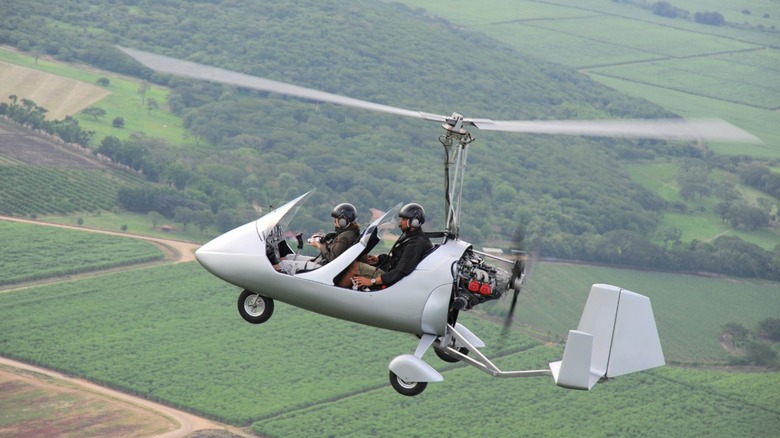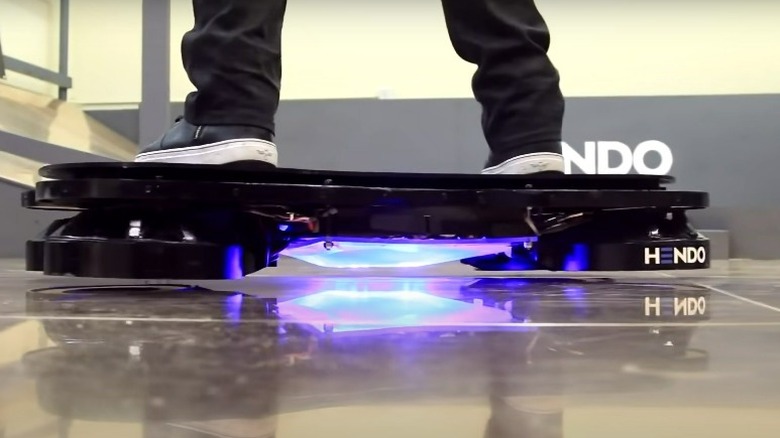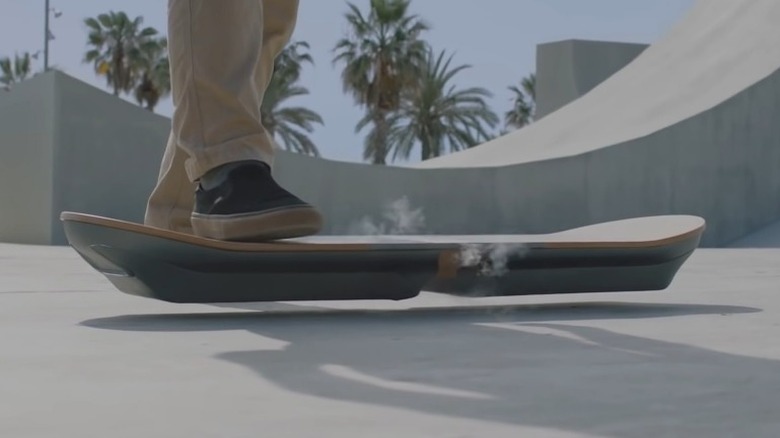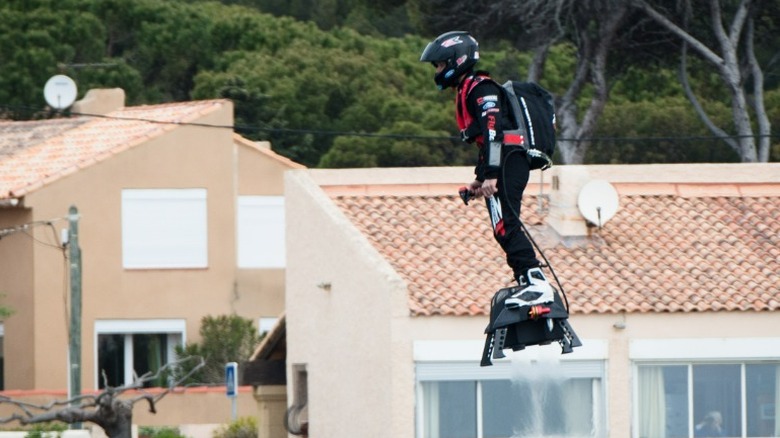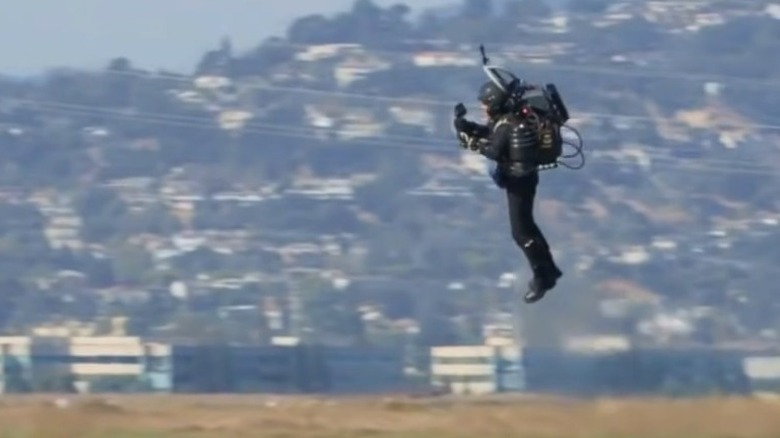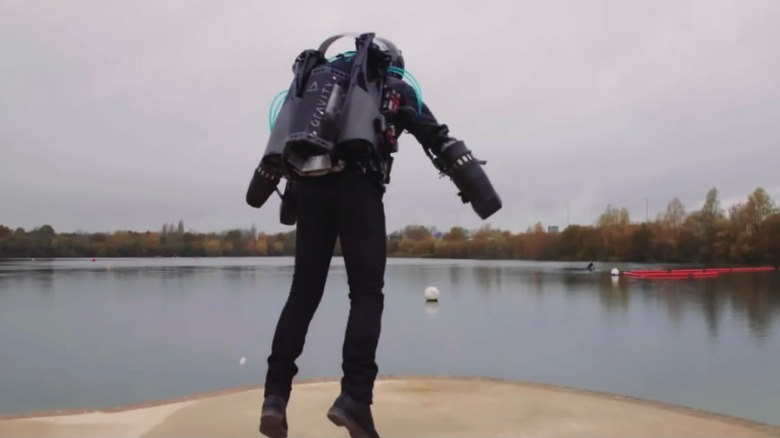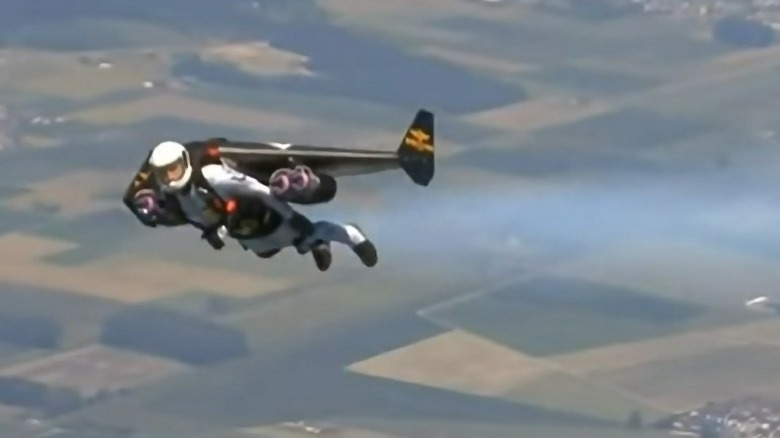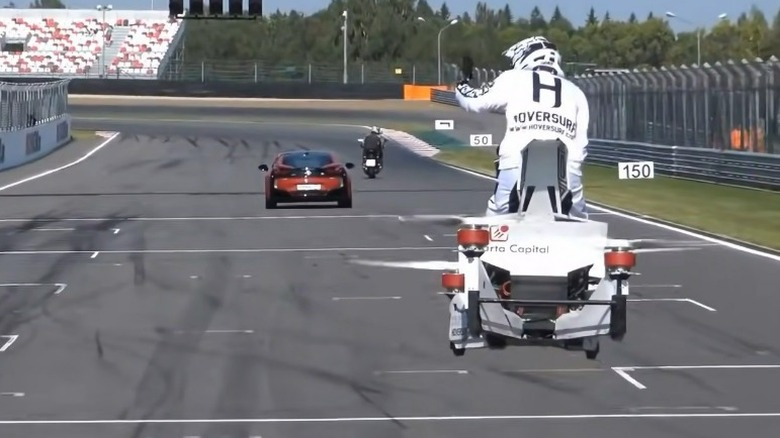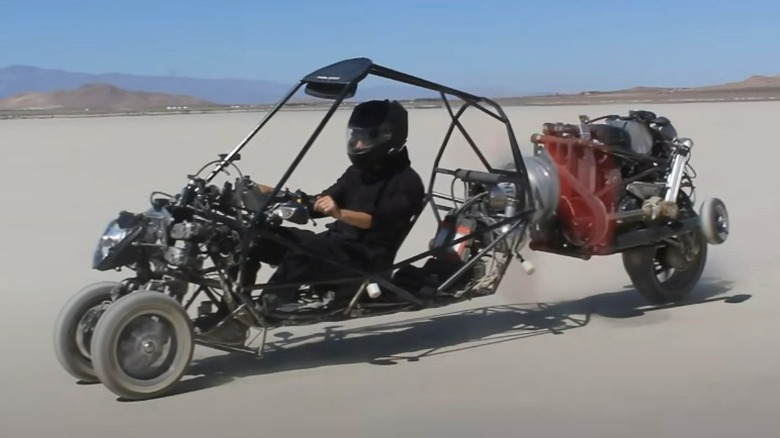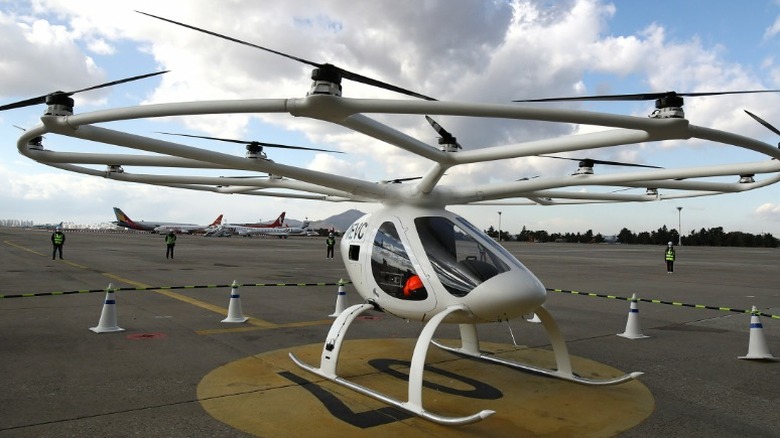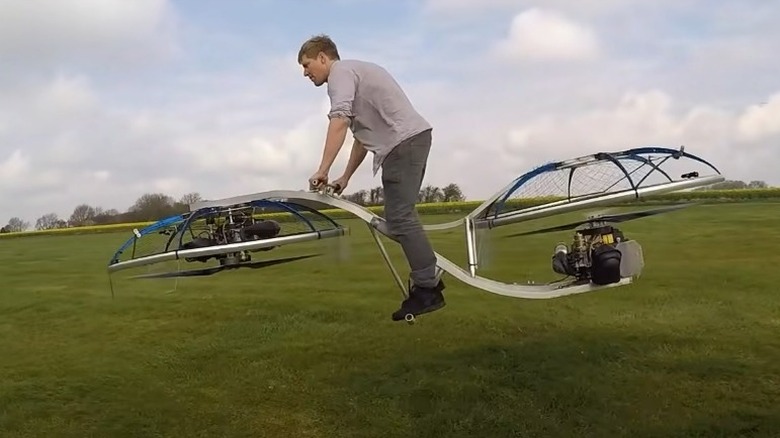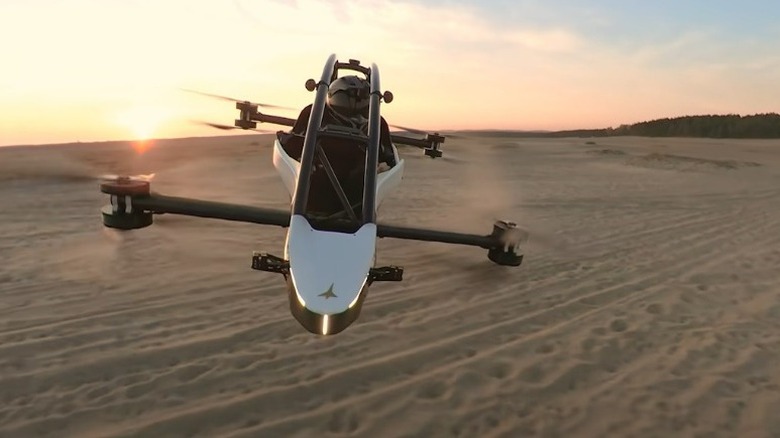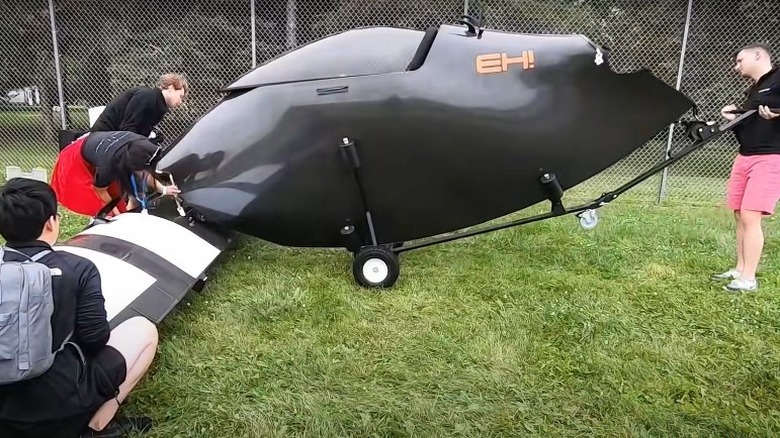The Gadgets That Will Make Your Flying Dream A Reality
All through history, humans have longed to fly like birds. Ancient mythology is full of tales of human flight, like the story of Icarus, whose father Daedalus fashioned wings for the two of them to escape confinement in a palace tower. Tragically, Icarus ignored his father's warnings and flew too close to the sun, melting the wax on his wings. In the 15th century, Renaissance painter, engineer, and scientist Leonardo da Vinci studied the flight of bats and birds and sketched mechanisms for wing-like devices with articulating mechanisms for flying.
While most efforts to create a personal flying mechanism have been unsuccessful, today, modern technology makes human flight feasible. Hundreds of companies and teams of engineers are currently working on solutions. In addition to the prospect of creating a marketable personal flyer that will reap financial benefits, there is even a $1 million prize offered for the best operating device.
Launched in 2017, GoFly, the personal flying device challenge sponsored by Boeing, is a competition to design and build a "safe, quiet, ultra-compact, near-VTOL personal flying device capable of flying 20 miles" while carrying a single person. As of September 2021, more than 850 teams from 103 countries are vying for the grand prize. New teams are still welcome to enter the competition. GoFly recently announced an extension of the deadline for its competition until September 2023. Here are a few of the gadgets that could make your flying dream a reality (and possibly win the $1 million prize).
Hendo Hoverboard
Marty McFly (played by Michael J. Fox) dazzled audiences when the teenager glided on air around the Hill Valley square in front of the famous clock tower in "Back to the Future Part II." The hoverboard that replaced the old-school skateboard used in the first film has inspired the development of several real-world devices. One such gadget is the Hendo Hoverboard, a proof-of-concept device developed by Greg Henderson that launched in a 2014 Kickstarter video. The Arx Pax Hendo Hoverboard levitates above the ground with Magnetic Field Architecture (MFA) technology using Lenz's law and four disc-shaped electromagnetic engines that induce an opposing magnetic field in the surface substrate over which it glides.
The hoverboard uses a powerful 1 4S- LiPo cell battery that provides a 10 to 15-minute ride on a single charge. Weighing 100 pounds, the board can levitate at a height of 1 inch and support a maximum load of 300 pounds. The stable device is maneuvered and driven forward and sideways by altering the force applied by the rider. Several safety features are included such as automatic shutdown, a safety switch, and remote control on/off.
Currently, the company employs simple sheets made of commonly available metals to give the hoverboard "flight." Unfortunately, it doesn't work over non-metal surfaces such as wood, concrete, or water. However, Hendo is testing new compounds and configurations to utilize the Hendo technology and reduce costs. The proof-of-concept vehicle is available on Kickstarter for $10,000. However, the company is hoping inventors will find uses for the technology and are also offering a Whitebox developer kit for $299.
Lexus Slide
The Slide is a skateboard-type hoverboard, introduced by the automaker Lexus, that floats several inches above the ground. Displaying the typical Lexus luxury style, the board features the company's iconic spindle grille signature shape. The deck is made from sustainable bamboo while magnetic levitation technology similar to that used in Japan's high-speed bullet train keeps the board floating in the air. The device employs superconductors and magnets cooled by liquid nitrogen to more than 300 degrees below zero to repel the force of gravity over a riding surface or special skatepark containing hundreds of magnets.
Although the Slide is operational, the company designed the hoverboard simply to promote the Lexus brand, with no immediate marketing plans for the product. To demonstrate the capabilities of its prototype hoverboard, Lexus built a custom skate park (complete with magnets) in Barcelona, Spain.
Despite the Slide's remarkable performance, some issues persist. During a demonstration, professional skateboarder Ross McGouran labored to keep the board from dragging on the ground. The resultant friction brings the board to a halt. The device must be refilled with liquid nitrogen every 10 minutes, severely limiting the length of any session. Yet, most observers are amazed when they watch the device float across the water, reminiscent of Marty McFly (played by Michael J. Fox) in "Back to the Future II."
Zapata Flyboard Air
In 2011, French inventor Franky Zapata developed the Flyboard, a hydrojet that uses water pressure to propel a rider through the air supplied by a long hose attached to a watercraft. The rider can fly up to an estimated 72 feet (22 meters) in the air and dive headlong into the water below. As impressive as the Flyboard is, Zapata later invented the Flyboard Air, a potentially much more beneficial board fitted with four turbojet engines that powers a rider through the air without any connections to a boat or the ground.
Zapata's Flyboard Air is a jet-powered VTOL personal aerial vehicle with exceptional individual mobility. A computer keeps it stabilized, and all critical systems are redundant ensuring flight safety in all conditions. However, controlling the flying vehicle requires the rider to achieve a high level of flight proficiency and to be in excellent physical condition.
Zapata has had much success demonstrating the device's capabilities. In 2016, he set the longest hoverboard flight world record when he piloted the Flyboard Air 2,252 meters (about 1.4 miles) along the south coast of France. Perhaps the most impressive achievement was Zapata's successful flight on the Flyboard Air across the English Channel. The trip began in Sangatte, France, and finished in Dover, England taking 22 minutes to complete. He reached speeds of up to 106 miles per hour during the 22-mile trip. Zapata was required to make a stop about halfway across the water to refuel because he only carried a 10-minute fuel supply.
Jetpack Aviation JB10
Jetpack Aviation designed the JB10 with sophisticated technology that allows the average person without piloting skills to fly. The craft and pilot are kept stable with gyroscopes and accelerometers that monitor the vehicle's orientation hundreds of times per second, constantly sending feedback to the system's control electronics and adjusting the thrusters. The JB10 replaces the JB9 model with an increase in fuel capacity and thrust, and it is fitted with more advanced computer engine controls and pilot displays. Two turbojet engines, each producing nearly 200 pounds of thrust, power the JB10. The engines can burn kerosene, Jet A-1, or diesel fuel.
The JB10 weighs 83 lbs. (empty), delivers a maximum thrust of 395 pounds, can reach a maximum speed of 120 mph, has an operating ceiling of 15,000 feet, and flies for up to eight minutes, depending on the pilot's weight and the density altitude. Jetpack Aviation has conducted extensive tests domestically and internationally with the JB10 over the past several years, including participation in the Red Bull Air Race events.
In 2018, Jetpack Aviation introduced the JB11, the successor to the JB10 which offers improvements in power, speed, and safety. The new model employs three turbojet engines per side instead of just one and can reach speeds over 150 mph. Exceptional maneuverability and speed control are achieved (on the JB9 and JB10, as well) by the pilot vectoring the entire engine, rather than just vectoring thrust. Perhaps the best features of the JB11 are the safety improvements. Should an engine fail, the jetpack can compensate and automatically re-balance the thrust to prevent a pilot from spiraling out of control.
Richard Browning jetpack suit
British inventor and consummate daredevil Richard Browning has created a gravity-defying jet suit that allows him to fly like a bird or perhaps like Tony Stark in the "Iron Man" movies. The device not only promises to fulfill the dreams of human flight, but it may also save lives. Browning built his jetpack by mounting six miniature jet engines to his arms and lower back. Although the suit looks like a DIY project with a mixture of engines, wires, motorcycle pads (or something similar), a large helmet, and heavy riding boots, it does enable human flight. The engines provide enough power to fly up to speeds of 85 mph and soar to an altitude of 12,000 feet.
While the device shows significant potential, controlling it requires an enormous amount of physical effort. Brown, an ex-Royal Marine, ultra-marathon runner, and endurance canoeist says the suit tests the limits of personal fitness requiring considerable strength to direct the jets. He has an exhaustive personal physical training program just to keep him in shape for the flights.
As a result, Browning says his suit will not be widely adopted by the public yet: "I don't think anyone is going to be going down to Walmart or taking the kids to school anytime soon in one of these things." However, the technology could be effective in emergency operations right now. The suit would allow paramedics to rescue injured hikers in remote mountain areas and reach stranded individuals in locations that are not accessible by vehicle or take hours to reach by foot.
Jetpack by Yves Rossi
Yves Rossy, nicknamed "Jetman," has been flying his winged jet pack creation since 2008, and has soared over the Dubai desert at a velocity of 125 mph. In the air, Rossy climbs and dives like a bird with the advantage of wing lift to boost flight efficiency (the lift-to-drag ratio). His early flights have always required a plane or helicopter for takeoff and a parachute to land. However, his latest model, the Jetcat P550 provides Human Vertical Take Off and Landing (HVTOL) capability with enough power to take off from the ground.
Rossy designed the wingsuit jet pack with semi-rigid, airplane-type carbon-fiber wings weighing 55 kg that span about 8 feet (2.4 meters). The original suit was powered by four small Jet-Cat P200 turbine engines modified from large kerosene-fueled model aircraft engines and attached using a custom harness. While the Rossi Jetpack demonstrated some stunning flying maneuvers once airborne, the inventor remained frustrated with the inability to take off from the ground and considered it the flying suit's biggest weakness.
With the newer Jetcat P550 model, Rossi has enough vertical lift to fly straight upwards at up to 112 mph. He has been working with a Swiss team of engineers to develop an autonomous, self-balancing vertical takeoff system activated by finger controls in his gloves. He is also working with a parachute developer to design a low-altitude parachute, making it safer to fly close to admiring crowds.
HoverSurf Scorpion 3
The HoverSurf Scorpion-3 is a flying device built with a motorcycle-type frame and it resembles a small dirt bike. Powered by electricity, the hoverbike uses quadcopter drone technology to fly and change direction and altitude. The lightweight single-element carbon fiber frame supports four propellers, the computer, the battery, and onboard flight system sensors. The Scorpion-3 Hoverbike includes software for both automatic and manual control. A security system powered by modern flight controllers features computer-aided management of speed and elevation with limits. Two leather-covered joysticks control the plane, and a pilot assistance program helps stabilize the aircraft during landing and taking off.
HoverSurf Scorpion-3 flight time on a full battery charge can last from 20 to 40 minutes depending on the pilot's weight and maneuvers executed during flight. The battery requires about three hours to recharge, or it can be swapped out in less than a minute. Depending on battery consumption the Scorpion-3 has a range of about 20 km, travels at a maximum speed of 69 kmh, and reaches an altitude of 4.5 meters (15 feet).
Hoversurf classifies the Scorpion-3 as an "extreme sports" vehicle, but the prototype demonstrates genuine potential as a device for personal transportation. It can also be controlled remotely, which may make it useful for transporting cargo without a pilot.
Dezso Molnar GT
Dezso Molnar, aeronautical engineer, pilot, and entrepreneur, has designed a vehicle that has been called a flying motorcycle or flying car but may be best described as a "gyrocycle." Inspired by the common desire of commuters to escape traffic when crawling forward at a snail's pace, Molnar hopes his design is "a step in the evolution of personal vehicles." "The GT takes a new approach to flying cars," he continues. "We are narrowing the mission. What really matters is the ability to fly into a congested area and then drive out of it."
Dezso built the proof-of-concept Molnar GT in a mere seven months in a bicycle factory with the help of a bicycle designer and machinist. He has flown (and driven) the street- and air-legal device with a proper license, registration, smog certificate, and insurance since 2005.
Molnar's design combines the technology of a gyrocopter for air travel and a motorcycle engine that drives the propeller and rear wheel for transportation on the ground. Gyrocopters (gyroplanes) have been around for a century with the first rotorcraft, the Autogiro, built by Spaniard Juan de la Cierva and flown in 1923. Like most gyrocopters, when the vehicle is pushed forward by a propeller, lift is created when the rotary wing spins in-flight caused by the wind created from forward motion. In the event of an engine failure, the autorotation allows the gyrocopter to descend slowly and safely while the pilot makes a controlled landing.
Volocopter
The research and development of VTOL aircraft for personal use is currently running rampant with hundreds of companies in the process of building a vehicle. Most of the designs include rotors for vertical takeoff and landing, but use regular fixed wings for horizontal flight. Volocopter has taken a different approach with a human-sized drone design using 18 rotors and no wings.
While most VTOL developers are focused on personal flying machines, Volocopter is targeting public services. The company is planning to launch "the world's first-ever eVTOL suite of services, replete with our signature passenger air taxis, heavy-lift cargo drones, and its very own ecosystem."
The German aircraft manufacturer based in Bruchsal selected the multirotor design over a standard helicopter for several reasons:
- An electric multirotor vehicle costs less than a helicopter to build and is significantly cheaper to operate (about 40%).
- It generates much less noise than a copter.
- Emissions are much lower, nearly zero.
- Electric motors are much more reliable than traditional internal combustion engines and less likely to fail. The vehicle can lose three rotors and still complete a safe power landing.
- The safer operation allows the electric multirotor to enter places where helicopters are banned.
- The rotors are shut down while on the ground making it easier to manage the vehicle and safer for passengers to embark and disembark.
The vehicle's limited range of an estimated 21 miles at a cruising speed of 44 mph makes long treks complicated. However, the vehicle is ideal for trips to the airport or travel over difficult terrain.
Colin Furze Hover Bike
While many startup companies pour thousands of dollars into research, design, and development of personal flying machines, one backyard inventor demonstrated that even the average person without any engineering experience can build one of these devices. Colin Peter Furze is a British YouTube personality, inventor, and stuntman from Stamford, Lincolnshire, England. A plumber by trade, he has used his practical experience to build many unconventional contraptions, including a jet-powered motorcycle made with pulsejet engines, the world's fastest mobility scooter, and the world's longest motorcycle in 2008 at 46.8 feet (the record has since been broken at over 100 feet).
Furze built his first DIY multicopter by mounting two Parajet two-stroke motors to the bottom of a metal frame with the propellers rotating in the same direction. However, he built a second device, an S-shaped frame that allowed each propellor to rotate in opposite directions. The design, allowing counter rotation of the propellors, reduced the effect of gyroscopic spin, making the device easier to control.
Furze considered adding a stabilization system, but the extra weight would have prevented the vehicle from getting off the ground with the already taxed motors. The device remained low-tech requiring Furze to control each throttle individually to stay airborne. Moving forwards or backward requires shifting the pilot's weight in either direction, and side-to-side movement comes from placing more weight on the appropriate foot. However, none of these techniques have much effect if the device enters a spin when the engines run at different speeds.
Jetson ONE
Anyone who watched television back in the '60s will remember the American animated sitcom "The Jetsons." The program first aired on Sunday nights from September 1962 to September 1963, and later in syndicated reruns. The comical cartoon portrayed the daily life of George Jetson and his family residing in Orbit City well above the ground more than 100 years in the future. A flying car was their mode of transport.
Swedish eVTOL startup Jetson has developed Jetson ONE, a personal electric aerial vehicle that the company believes is the beginning of transportation that will someday rival that of the TV series. After a successful prototype built in 2018, Jetson has released its consumer-grade version of the ONE eVTOL.
The Jetson ONE has been described as a "formula one racing car for the sky." Made with aluminum and carbon fiber, the personal aerial vehicle uses eight powerful motors driving eight propellers. The flying car carries a single passenger up to a weight of 210 pounds, and it can fly for up to 20 minutes. The batteries will fully recharge using household-standard 110V in about two hours but need only one hour to recharge at 230/240V. The Jetson ONE is classified as an ultralight aircraft, so a pilot's license is not required. The company claims anyone can learn to fly the device in five minutes and it includes a two-day training course at one of the company's Experience Centers for buyers.
Opener Blackfly V1
The Blackfly personal eVTOL aircraft, designed and built by Opener, an aerospace company headquartered in Palo Alto, California, resembles two boat hulls, one inverted on top of the other. The vehicle has two wings, attached to the front and rear, and four electrically powered propellers attached to each wing. Opener designed the Blackfly with safety as its highest priority. The vehicle features triple-modular redundant flight systems, control surfaces, and sensors to guarantee a risk-free flight.
Via FutureFlight, according to Opener's director of operations Kristina Melton, the stability system automatically activates when the flight computers detect a flight scheme "beyond what the aircraft thinks is controllable," maintaining hover or cruise altitude. The aircraft also includes a "return to home" feature like those found on hobby drones. The company also fitted the aircraft with a ballistic recovery parachute system with dual redundant activation for emergencies.
Classified as an ultralight, the Blackfly operates under federal air regulations Part 103. The aircraft is limited to a maximum pilot weight of 200 pounds, cannot be flown near populated areas, and only operate during daylight hours (visual flight rule conditions). Opener says the Blackfly production model will have the capability to climb to 1,200 feet, reach a top speed of 62 mph, and have a range of 30 miles on a full battery charge. Opener said the company expects to start taking orders from customers in 2023 and sell up to 25 of its ultralight category, computer-operated aircraft before the end of the year.
